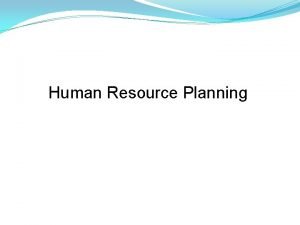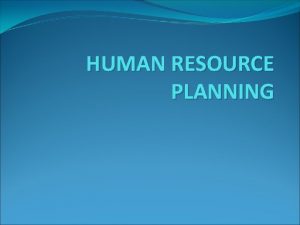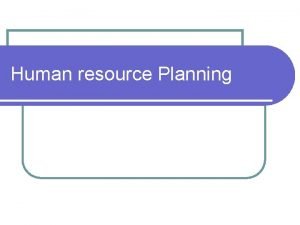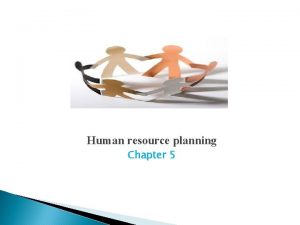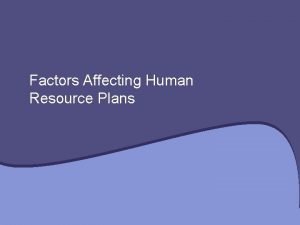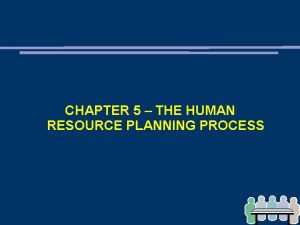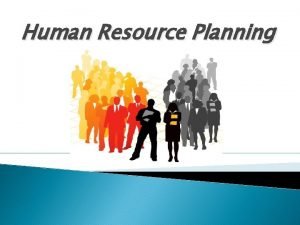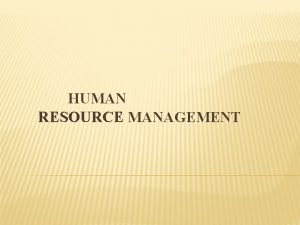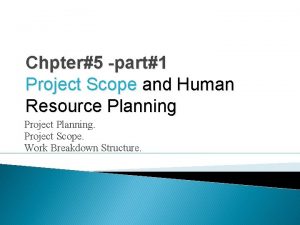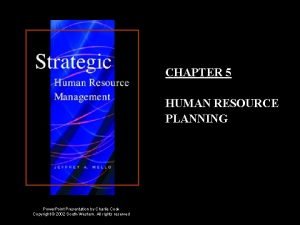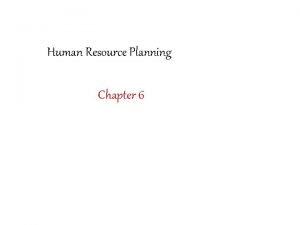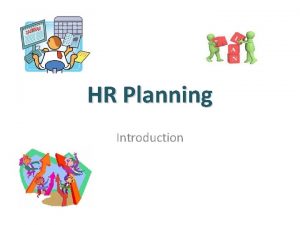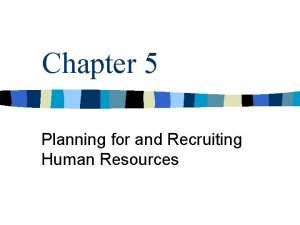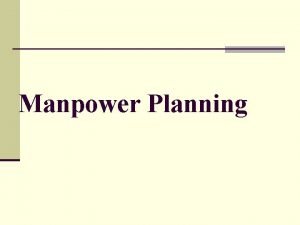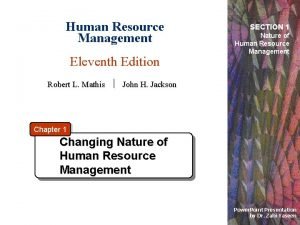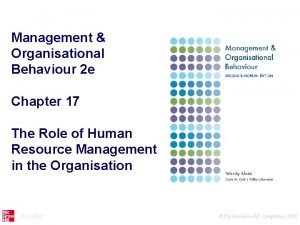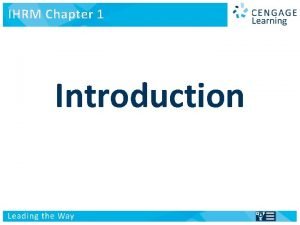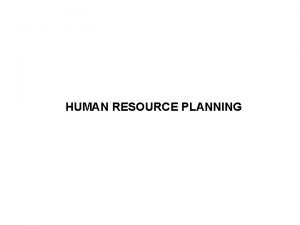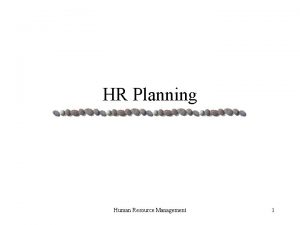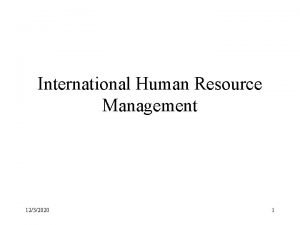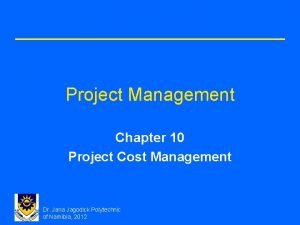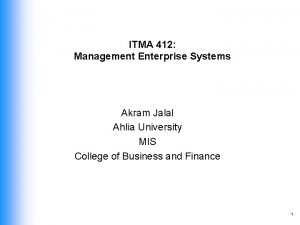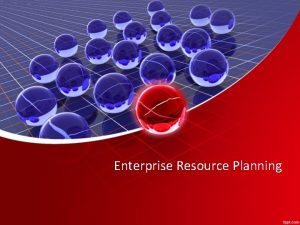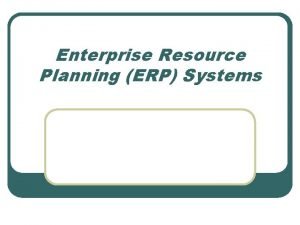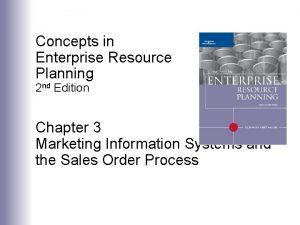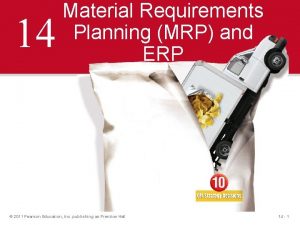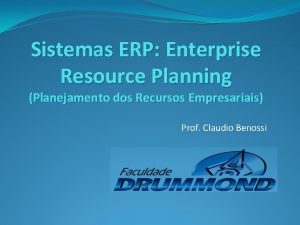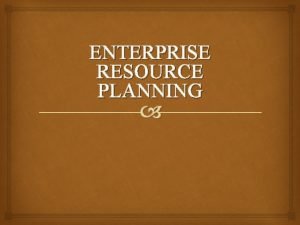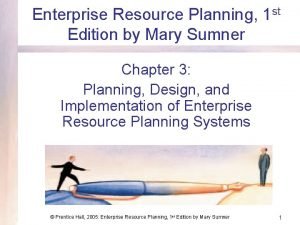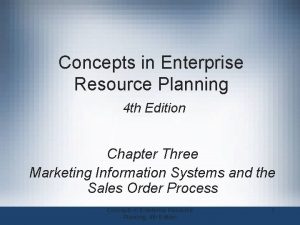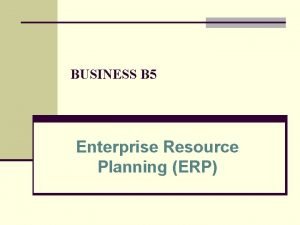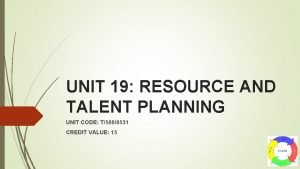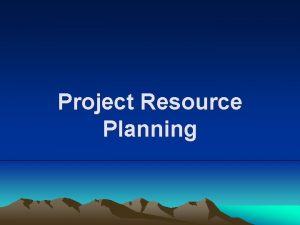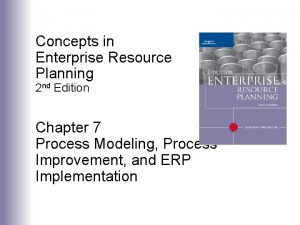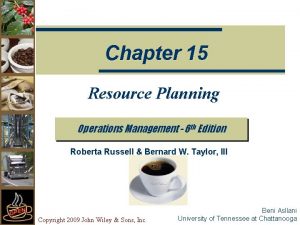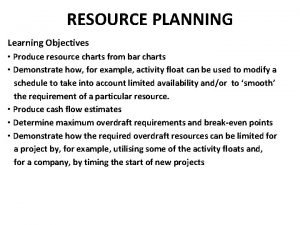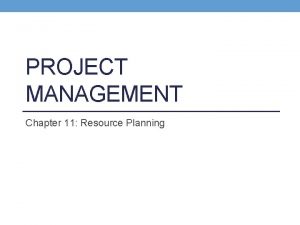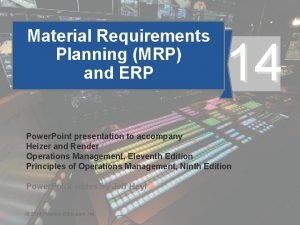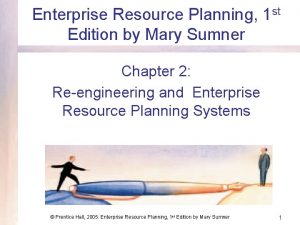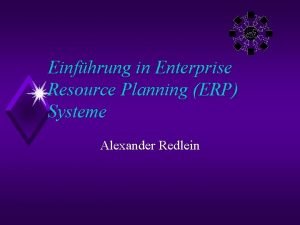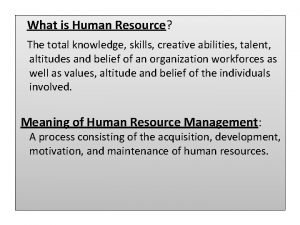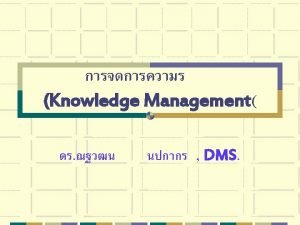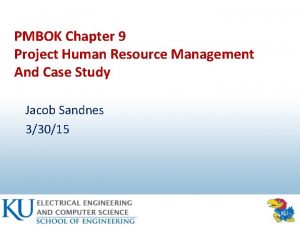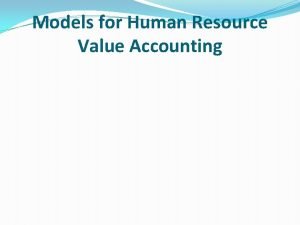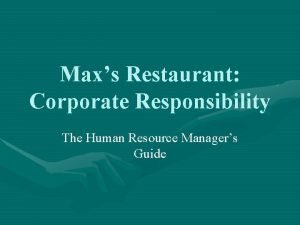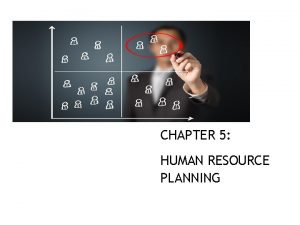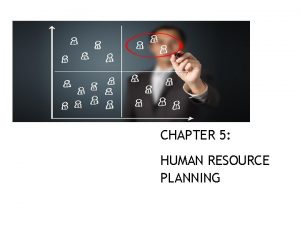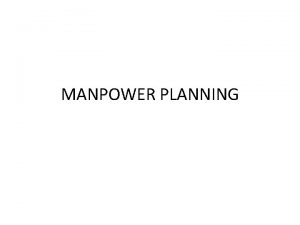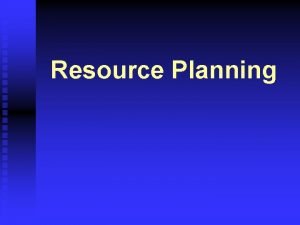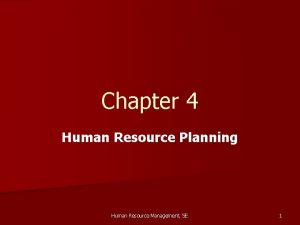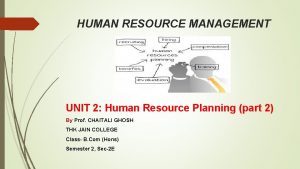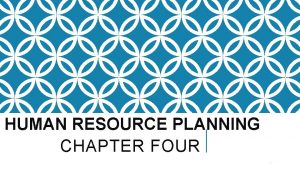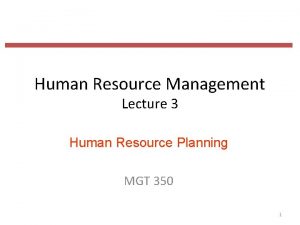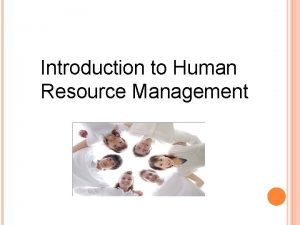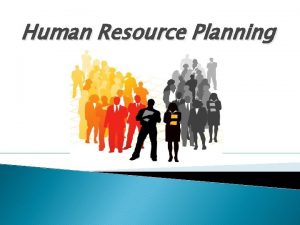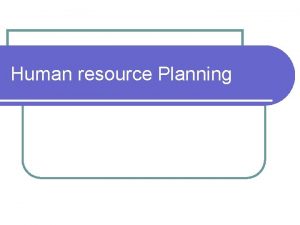Human Resource Planning Meaning Human Resource Planning is


























































- Slides: 58

Human Resource Planning

Meaning � Human Resource Planning is, the planning of human Resources. It is also called manpower planning/ personnel planning/ employment planning. � It is only after Human Resource Planning that the Human Resource department can initiate the recruitment and selection process. Therefore Human Resource Planning is a sub-system of organizational planning.

Definition �Human Resource Planning is a strategy for the acquisition, utilization, improvement and preservation of an organization's human resource” – Y. C. Moushell �“Human Resource Planning is a process of forecasting an organization's future demand for human resource and supply of right type of people in right numbers” – J. Chennly. K

Defining HR Planning AIMS of HRP: 1. To ensure the optimum use of the people currently employed 2. To provide for the future staffing needs of the organization in terms of skills and number.

Human Resource Planning Organizational Objectives Human Resource Planning Forecasting supply of human resources Forecasting needs for Human Resources Identification of human resource gap Surplus Human Resources Shortage of human resources Action plans 5

Human Resource planning �Human Resource Planning (HR Planning) is both a process and a set of plans �It is how organizations assess the future supply of and demand for human resources. �An effective HR plan also provides mechanisms to eliminate any gaps that may exist between supply and demand. Thus, HR planning determines the members and types of employees to be recruited into the organization in phased manner.

Labour Market = Labor supply + Labor demand �A labor market is a geographical area within the sources of supply [people looking for work] interact with the forces of demand [employers looking for people] and thereby determine the price of labor. �Demand for labour is a derived demand - not wanted for its own sake but for what it can contribute to production

Labor Supply �Labor supply is the availability of workers who possess the required skills that an employer might need. �Factors affecting Supply of Labor: 1. Population growth – births, deaths, migration, age 2. Education & Training. 3. Opportunity cost of Work. 4. Social demand. 5. Wage levels and working conditions. 6. Career guidance, counseling, job information etc.

Labor Demand �Labor demand is the number of workers an organization needs. �Factors affecting labor demand: 1. Technology 2. Changing demand patterns of consumers. 3. Public savings and investment trends. 4. Labor laws regarding workers, safety, reward etc 5. Labor productivity

Need for Human Resource Planning 1. organization needs competent staff with the necessary qualifications, skills, knowledge, work experience and aptitude for work. 2. Since employees exit and organization both naturally (as a result of superannuation) and unnaturally (as a result of resignation), there is an on -going need for hiring replacement staff to augment employee exit. Otherwise, work would be impacted. 3. In order to meet the need for more employees due to organizational growth and expansion, 4. Often organizations might need to replace the nature of the present workforce as a result of its changing needs, therefore the need to hire new set of employees. To meet the challenge of the changed needs of technology / product/service innovation the existing employees need to be trained or new skill sets induced into the organization. 5. Manpower planning is also needed in order to identify an organizations need to reduce its workforce.

Objectives of Human Resource Planning �Optimum utilization of human resources currently employed in the organization. �To reduce imbalance in distribution and allocation of manpower in organization for various activities. �To ensure that the organization is well-equipped with the required Quantity and Quality of manpower on a sustained basis. �To predict the impact of technology on jobs and resources. �To control cost of Human Resources employed, used and maintained in the organization. �To improve the standards, skill, knowledge ability, discipline etc.

Importance of Human resource Planning �utilization of human resources �Prepare people for future �Expand or contract �Cut costs �Backup staff �To achieve an integration �Create reservoir of talent �Prepares people for future �Expand or Contract �Succession Planning

1. 2. 3. 4. 5. 6. 7. 8. 9. Organisation plan includes Average costs of recruitment per year. Average cost of recruitment per staff. Average cost of training per year. Percentage training cost. Sales turnover or productivity. Health safety cost per year. Compensation and benefit cost Training cost per employee. Salary budget ratio/sales turnover.

JOB ANALYSIS 14

Job Analysis �Job analysis is the process of gathering information about a job. It is to be more specific, a systematic investigation of the tasks, duties and responsibilities necessary to do a job. Job analysis is the formal process of identifying the content of a job in terms of activities involved and attributes needed to perform the work and identifies major job requirements. Job analysis was conceptualized by two of the founders of Industrial/organizational psychology, Fredrick Taylor, and Lillian Moller Gilbreth in the early 20 th century

Definitions (Continued) �Job analysis - Systematic process of determining the skills, duties, and knowledge required for performing jobs in an organization �Job description – Document providing information regarding tasks, duties, and responsibilities of job �Job specification – Minimum qualifications to perform a particular job 16

Job Analysis: A Basic Human Resource Management Tool Tasks Responsibilities Duties §Human Resource Planning §Recruitment §Selection §Placement and orientation Job Descriptions Job Analysis §Training and Development Job Specifications §Counseling §Performance Appraisal § Employee safety Knowledge Skills Abilities §Job design and redesign §Job evaluation 17

Nature of job analysis Job Tasks Job Analysis Job Duties Job Responsibilities

Nature Of Job Analysis Job analysis is an important human resource activity. 1. Task is an identifiable work activity. 2. Duty is larger work segment consisting of tasks. 3. Responsibilities are obligations to perform certain tasks and duties § It Identifies what people should do in job. n Work activities and behaviors n Interactions with others n Performance standards n Financial and budgeting impact n Machines and equipment used n Working conditions n Supervision given and received n Knowledge, skills, and abilities needed 19

Significance or uses of job analysis �Human resource planning • Forecasting Human resource requirements • Facilitates the formulation of systematic promotion and transfer policy. • Helps in determining Quality of human resource needed in organization. �Recruitment. • How and when to hire people for future job openings. • Understanding the skills needed for positions vacant �Selection. • Proper understanding of job • Ex: Super market 20

�Placement and orientation: • Place them on jobs based on interest, activities and knowledge. • What work needs to be done • Clearly define a job �Training and Development: • Proper training efforts should be initiated. • Additional training can be determined after the specific needs of job have been identified through job analysis. �Counseling: • Managers should properly counsel the employees about careers. • Employees should understand the specific needs of various other jobs • Helps employee to develop further a carrier. 21

Use of job analysis �Employee Safety: • Unsafe condition should be taken care. �Performance appraisal: • Comparing employee with actual standards • Pay fair remuneration based on performance. �Job Design and Redesign • Locate weak spots and undertake remedial steps • Eliminate unnecessary steps • Redesign a job to match the mental make up of employees Job evaluation: • Helps in finding relative worth of job. • Helps to assist in designing proper wage policies, With internal pay equity between jobs. 22

When do you carry out job analysis It is carried out on three occasions: 1. When new organization is established. 2. when new jobs are created. 3. When job undergo radical transformation changes in • New technologies • Methods • Procedures or system 23

Linking Organizational Strategy to Human Resource Planning


Process of Job Analysis Jobs can be analyzed through a process, which consists of five steps. 1. Organisation analysis It involves • Obtain Information about various jobs in the organisation • Analyse the linkages between jobs and organisational objectives and interrelationship between the critical jobs • The required background information for this purpose is obtained through organisation charts and work flow charts 2. Selection of representative positions to be analyzed: It would be highly difficult and time-consuming to analyze all the jobs. So, the job analysis has to select some of the representative positions in order to analyze them.

3. Collection of job analysis data: This step involves the collection of data on the characteristics of job the required behavior and the personal qualifications needed to carry out the Drop efficiently several techniques are available for conducting fetch data but care should be taken to use only reliable and acceptable techniques in a given situation Sources of Data may be obtained from the employees who actually performs the job other employees sector supervisors managers and foremen to watch the workers while doing the job and their by acquire knowledge about it Outside observer specially appointed employees performing a job. such outside persons are called job analysts and sometimes special job reviewing committees are also established

Methods of data collection- job analysis �Personal observation- the analyst observes the workers doing the job. The task performed the pace at which the activities are done, working conditions etc. Observed during a complete work cycle. �Job performance- job analyst actually performs the job in question and does received first hand experience of contextual factors on the job including physical hazards social demand mental requirements etc. This method is useful for jobs that can be easily learned �Developing a job description -This step involves describing the contents of the job in terms of functions, duties, responsibilities, operations etc. The incumbent of the job is expected to discharge the duties and responsibilities and perform the functions and operations listed in job description.

5. Developing a job specification: This step involves conversion of the job description statements into a job specification. Job specification or job requirements describes the personnel qualities, traits, skills, knowledge and background necessary for getting the job done. 6. Developing employee specification: This final step involves conversion of specification of human qualities under job specification into an employee specification. Employee specification describes physical qualifications, educational qualifications, experience requirements etc. , which specify that the candidate with these qualities possess the minimum human qualities listed in the job specification.

�Panel of experts- uses senior job incumbents and superiors who have extensive job knowledge. To get the job analysis information the analysts conducts an interview with the experts. �Critical incidents critical incident are recorded by analyst, superior or by employee himself. The analyst then categorizes this incident as effective and ineffective behavior. �Interview- the interviews collects accurate and complete data, the important attitudes of the interviewer are �The interviewer should introduce himself to the workers �You should not tell the employee how to do the job �He has to do a complete job study �He should not confuse the work with the worker. You should analyse the job and not worker �Information sources for the interviews can be �Individual employees �groups of employees �Superiors with knowledge of the job

Job description �A written statement of what the worker actually does how he or she does it and what the jobs working conditions are included �List of jobs duties responsibilities reporting relationships working conditions and supervisory responsibilities Sections of a typical job description include �Job title- describes the position and department �Job summary- brief write up about the job �Job activities- description of the responsibilities and duties �Standards of performance- expected results �Working condition - physical environment

Contents of job description v. Job Title. Job title, code number, department v. Job Summary: A brief up. v. Job Activities v. Working Condition Heat, light, noise and hazards. v. Social Environment Size of work group and interpersonal interactions required to do the job. 32

Problems of job Description Job description serves as a valuable guide both for employer and employees. 1. It is not easy to reduce all the essential components of a job in the form of a clear and precise document. 2. Job descriptions are sometimes are not updated as job duties change 3. They can limit the scope of activities of the job holder, reducing organisational flexibility. 33

�Job specification- written statement of personal attributes in terms of education experience case is to perform a particular job. �It is a statement of the minimum acceptable qualification that an employee must possess to perform a given job successfully. Ø Minimum acceptable qualifications that a person should possess in order to perform a particular job Ø It summarizes human characteristics needed for satisfactory job completion. Its specifies �Education �Experience �Knowledge �Physical skills �Communication skills �emotional characteristics

Attributes of Job Specification The personal attributes that are described through a job specification may be classified into three categories • Essential attributes. Skill, knowledge and abilities a person must possess. • Desirable attributes. Qualification of a person • Contra – indicators. Attributes that become a successful job performance. ü It can be developed by talking to current job holders about attributes to do the job. ü Supervisors can be used as an additional inputs. ü It is useful in selection process – explains clear set of qualification of an individual to be hired for a specific job. ü A well written job specification offers a clear picture to new recruits. 35

RECRUITMENT

Introduction To recruitment �Once the required number and quality of talents are determined, the management has to find the means of attracting them towards the organization before selecting suitable candidates for jobs. �All this process is generally known as “RECRUITMENT”. �Recruitment is the main factor from which the success of the entire organization depends on.

Recruitment �The process of finding and hiring the bestqualified candidate (from within or outside from an organization) for a job opening, in a timely and cost effective manner. �The recruitment process includes analyzing the requirements of a job, attracting employees to that job, screening and selecting applicants, hiring, and integrating the new employee to the organization.

According to Edwin B. Flippo � “Recruitment is the process of searching the candidates for employment and stimulating(encouraging|) them to apply for jobs in the organization”. �Recruitment is the activity that links the employers and the job seekers. �Recruitment refers to the process of attracting, screening, selecting, and onboarding a qualified person for a job

A few definitions of recruitment are �Recruitment is defined as, "the process of finding and attracting capable applicants for employment. �According to Desler, Recruitment means finding and attracting a fairly large number of well qualified applicants for the employers’ open positions.

• Recruitment aims at 1. Attracting the large number of qualified applicants who are ready to take up the job, if it is offered. 2. Offering enough information for unqualified persons to self select themselves, ex: The recruitment ad of a foreign bank may invite applications from charted accountants, who have cleared the CA examination in the first attempt.

Objectives of Recruitment �To attract people with multi-dimensional skills �To fill fresh blood at all levels of organization. �To search/head-hunt people whose skills fit the company’s values. �To search for talent globally. �To predict and find people for positions that do not exist. �Determine present and future manpower requirements of the organization in coordination with planning and job analysis activities.

�Support the organization ability to acquire, retain and develop the best talent and skills. �Obtain the number and quality of employees that can be selected in order to help the organization to achieve its goals and objectives. �Create a pool of candidates so that the management can select the right candidate for the right job from this pool �Attract and encourage more and more candidates to apply in the organization �Increase the pool of candidates at minimum cost. �Acts as a link between the employers and the job seekers

Significance of recruitment �Determine present/future requirements of firm in conjunction(instance of two or more events or things occurring at the same point) with its personnel planning. �Increase the pool of job candidates at minimum cost. �Help to increase the success rate of selection process. �Meet organizations legal/social obligations regarding composition of its workforce. �Increase organizational/individual effectiveness in short/long run. �Help the firm to create more culturally diverse work force. refers to policies and practices that seek to include people within a workforce who are considered to be in organisation.

Recruitment v/s Selection �The function of Recruitment precedes the selection function and it includes only finding, developing the sources of prospective employees and attracting them to apply for jobs in an organization. � where as Selection is the process of finding out the most suitable candidate to the job out of the candidates recruited.

What is Selection To select means to choose. Selection is the process of picking individuals who have relevant qualifications to fill jobs in an organization. The basic purpose is to choose the individual who can most successfully perform the job, from the pool of qualified candidates. �It is a deliberate( intentional) effort of the organization to select a fixed number of personnel from a large number of applicants. �The primary aim of selection is to choose those persons who are most likely to perform the jobs with maximum effectiveness and to remain with the company.

Purpose of Selection �Select suitable candidate. �Determine applicant’s capabilities. �Place right candidate at right job. �Generate information about candidate. �To save cost. Pre-requisites of Selection Procedure �Development of Job analysis. �HRP. �Candidates have been attracted. �Employee specifications. �Recruitment

Three essentials of selection procedure �Someone is to have the authority to select. �JD and JS to be available beforehand. �There must be sufficient number of applicants from whom the required number of employees must be selected Factors affecting selection Procedure �Profile matching. Possible care is to be taken to match the candidates bio data with Job specification. �Organization and social environment. �Successive hurdles. It is a means to say that hurdles in form of different rounds are created at every stage of the selection process.

SELECTION PROCESS 1. 2. 3. 4. 5. 6. 7. 8. 9. Preliminary Interview Selection Tests Employment Interview Reference and Background Checks Selection Decision: Physical Examinations Job Offer Contract Of Employment Evaluation of Selection program

1. Preliminary Interview: The purpose of this interview is to scrutinize the applicants, i. e. elimination of unqualified applications. 2. Selection Tests: Different types of selection tests may be administrated, depending on the job and the company. Generally tests are used to determine the applicant’s ability, aptitude, and personality.

3. Employment Interview: The next step in the selection process is employment interview, an interview is conducted at the beginning, and at the selection process of the employment interview can be one- to-one interview or panel interview. 4. Reference and Background Checks: Many employers request names, address, telephone numbers or references for the purpose to verify information and gaining additional background information of an applicant.

5. Selection Decision: Selection decision is the most critical of all steps in selection process. The final decision has to be made from the pool of individuals who pass the tests, interviews and references checks. 6. Physical Examinations: After selection decision and before the job offer is made, the candidate is required to undergo a physical fitness test. A job offer is often; contingent upon the candidate being declared fit after the physical examinations.

7. Job Offer: The next step in selection process is job offer. Job offer is made through a letter of appointment. Such a letter generally contains a date by which the appointee must report on duty 8. Contract Of Employment: Basic information is written in Contract of employment that varies according to the levels of job. After the offer and acceptance of the job certain document is the attestation form. 9 Evaluation of Selection program: The broad test of effectiveness of the selection process is a systematic evaluation . a periodic audit is conducted in the HR department that outlines and highlights the areas which need to be evaluated in the selection process


SELECTION PROCEDURE. HIRING DECISION REFERENCE CHECKS MEDICAL EXAMINATION SELECTION INTERVIEW SELECTION TESTS 4 APPLICATION BLANK 3 SCREENING INTERVIEW 2 RECEPTION Step 8 Step 7 Step 6 Step 5 Step 1

Application Blanks Contents of Application Blanks: �Personal data (address, sex, identification marks) �Marital data (single or married, dependents) �Physical data (height, weight, health condition) �Educational data (levels of formal education, marks) �Employment data (past experience, reasons for leaving previous job, salary drawn, etc. ) �Extra-curricular activities data (sports/games, NSS, etc. ) �References (name of two or more people who certify the suitability of an applicant to the advertised position)

Selection Tests (a) Aptitude Tests (b) Personality Tests (c) Interest Tests (d) Performance Tests (e) Intelligence Tests (f) Knowledge Tests

Selection Interview (a) The non-directive interview (b) The directive or structured interview (c) The situational interview (d) The behavioral interview (e) Stress interview (f) Panel interview
 Meaning of manpower planning
Meaning of manpower planning Human resource planning definition
Human resource planning definition Human resource plan definition
Human resource plan definition Delphi technique in hrm
Delphi technique in hrm Short term hr planning
Short term hr planning Steps of human resource planning
Steps of human resource planning Human resource management exam questions
Human resource management exam questions Factors affecting human resource management
Factors affecting human resource management Forecasting techniques in human resource planning
Forecasting techniques in human resource planning Definition of induction in hrm
Definition of induction in hrm Swot analysis introduction
Swot analysis introduction Geister meaning
Geister meaning Scope of human resource planning
Scope of human resource planning Human resource planning model ppt
Human resource planning model ppt Human resource planning definition
Human resource planning definition Hr definition
Hr definition Chapter 5 personnel planning and recruiting
Chapter 5 personnel planning and recruiting Advantages of manpower planning
Advantages of manpower planning Nature of human resources management
Nature of human resources management Markov analysis in hr
Markov analysis in hr Human resource planning steps
Human resource planning steps Define international human resource management
Define international human resource management Importance of human resource planning
Importance of human resource planning Wastage analysis in hrp
Wastage analysis in hrp Human resource planning wikipedia
Human resource planning wikipedia International hrm definition
International hrm definition Resource allocation vs resource leveling
Resource allocation vs resource leveling Perbedaan antara resource loading dan resource levelling
Perbedaan antara resource loading dan resource levelling Resource aggregation in project management
Resource aggregation in project management Enterprise resource planning example
Enterprise resource planning example Erp meaning
Erp meaning Enterprise resourse planning systems
Enterprise resourse planning systems Enterprise resourse planning
Enterprise resourse planning Cayenta workflow management
Cayenta workflow management Material requirements planning
Material requirements planning Sistema erp adalah
Sistema erp adalah Erp adalah
Erp adalah Enterprise resource planning mary sumner
Enterprise resource planning mary sumner Concepts in enterprise resource planning
Concepts in enterprise resource planning Core and extended erp components
Core and extended erp components Contemporary management ppt
Contemporary management ppt Resource and talent planning
Resource and talent planning Resource planning definition
Resource planning definition Fitter snacker
Fitter snacker Resource planning in operations management
Resource planning in operations management Gno5aq6ri0 or 7adh2
Gno5aq6ri0 or 7adh2 Resource planning definition in project management
Resource planning definition in project management Material requirement planning table
Material requirement planning table Enterprise resource planning mary sumner
Enterprise resource planning mary sumner Sistem enterprise resource planning
Sistem enterprise resource planning Jaggi and lau model, values the human asset
Jaggi and lau model, values the human asset Human resource development framework
Human resource development framework Time management human resources
Time management human resources Resource management pmp
Resource management pmp Aboriginal human resource council
Aboriginal human resource council Project human resource management pmbok
Project human resource management pmbok Lev and schwartz model example
Lev and schwartz model example Mba meaning
Mba meaning Human resource management in restaurants
Human resource management in restaurants
